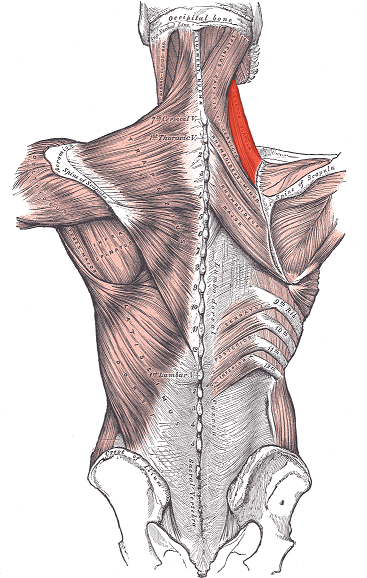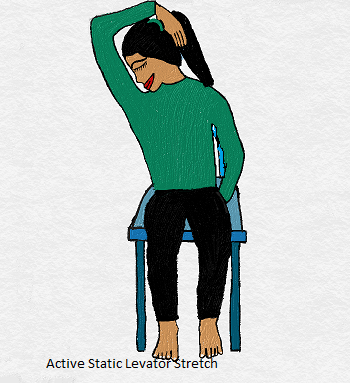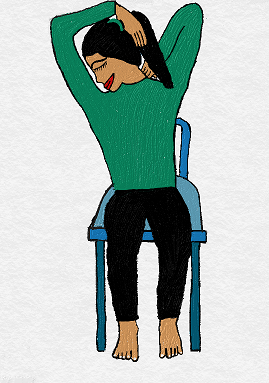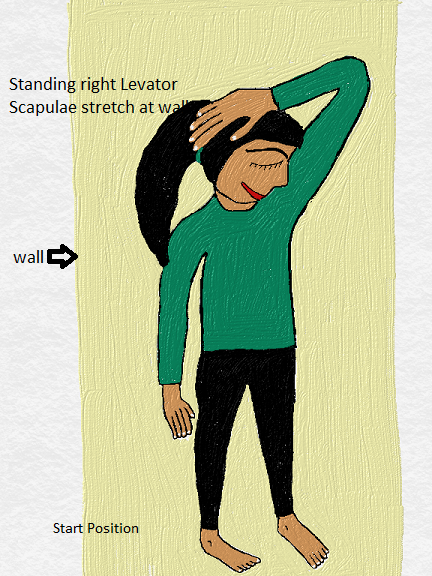|
Proceeding further cranially, let’s consider the neck stretches. Today we will look at the levator scapulae.
The levator scapulae is a thin and flat muscle that originates from the transverse processes of the first four cervical vertebrae and inserts into the medial border of scapula from the superior angle to the junction of spine of the scapula. This muscle functions to rotate the neck and side-bend to the same side and extend the neck. When the cervical spine is stationary, it rotates the scapula downwards with unilateral action, and working bilaterally elevates the scapulae as in a shoulder shrug. It tightens when there is a forward head posture with a rounded upper back thus resulting in the muscle being used for postural purposes when it is a phasic muscle designed for movement. It is also tightened orat unease when one holds neck in prolonged lateral flexion with rotation- like when holding a phone hands-free between the shoulder and ear. We will consider the right levator scapulae stretch to keep things straightforward. To stretch the left muscle follow instructions contralaterally. Passive Stretch By far the most effective way to release a tight levator muscle is to have a physical therapist or a trained professional use manual techniques for immediate relief. And then perform a passive stretch to bring the released muscle through the available range of motion. The levator scapulae is stretched passively in the supine position with the head supported on a mat. This position allows the muscles in the scapula-thoracic area and in the cervical spine to relax. The therapist then sits with chest at level of mat and cradles the occiput within the left cupped hand. This hand then rotates the cervical spine about 45 ° to the left and lifts it up into cervical flexion while the heel of the right hand simultaneously placed at the superior angle of the right scapula, pushes it downwards and away from the cervical spine, thus stretching the muscle fibers through both the insertions. This stretch is held for 15-30 seconds and is essential for the therapist to support the elbows on the mat to hold a sustained stretch, safely, permitting the patient to be at ease. Active Stretch To stretch this muscle, it takes a small amount of movement at the neck and scapula, however, the starting position with a neutral upright spine is of paramount importance to achieve the stretch accurately. Active Static Stretch: i) This is done in an upright seated posture on the chair or edge of mat with the feet firmly supported on the ground. The knees are hip width apart with thighs parallel. The ischial tuberosities are weight bearing with the pelvis in neutral position and a natural lumbar lordosis. The shoulders are directly over the hip joints while the spine is maintained in elongated position with the scapulae gently pulled back. This automatically puts the cervical spine in good starting position. The head is turned to the left about 45 ° or with the chin pointing to left knee. Next bend the neck forward and slightly to the side (as in bringing the ear closer to the left shoulder). The right arm is extended behind the trunk and the scapula is depressed or lowered to experience the stretch. Hold this position for 5-30 seconds and release. Repeat 2-3 times. ii) A slight variation to the above stretch is when the right arm is elevated overhead and then flexed at elbow with the hand reaching the medial border of the right scapula. This rotates the glenoid fossa of the scapula upwards and in the process the superior angle moves down, pulling the scapular insertion of the levator away from its origin in the cervical spine, thus stretching it. Both the above techniques cause the reciprocal inhibition of the levator scapulae by engaging the lower trapezius (scapular depressor) and the upper trapezius and serratus anterior (scapular upward rotators), respectively. Holding the stretch for a prolonged period also causes autogenic inhibition of stretched muscle fibers. (P.S.- the 2 pictures of seated levator stretch and its variation show left levator stretch) Active Dynamic Stretch: i) This may be done at a wall in the standing position, feet hip width apart and few inches from the wall. Stand with the back along the wall and the scapula retracted to make maximal contact with the wall. The scapulae are then depressed bilaterally and this position is held for 1-2 breath cycles. Next turn the head 45° to the left and look down with a slight side bend and forward flexion to left so that gaze is directed to left big toe. Bring the left hand behind the head with fingers on the occiput and hold the head position firmly. Without elevating the right scapula (no shoulder shrug), raise the right arm overhead and into shoulder elevation. Hold end position for 2-3 seconds as you breathe in and exhale as you lower the arm beside the trunk. Repeat 4-5 times for 1 set. Do 2-3 sets. Stretch with Equipment and Tools: i) A foam roll placed on floor perpendicular to the spinal column at the level of the shoulder blade or scapula does wonders to stretch the upper back muscles. Slowly move the foam roll upwards while lying on it, face up. When the foam roll is just a few inches below the neck, rest the back on the floor with the legs bent at hip and knees, feet on floor (hook lying position). Hold the foam roll at the upper scapular border and let the body weight sink you into the roll. Move the roll up further along the spine till the base of cervical spine and hold for few seconds. Turn the neck side to side when the roll fits into the lordosis of the spine to release the muscle insertion on the transverse processes of the vertebrae. ii) The foam roll may be arranged vertically along the spine and rolled side to side to release the muscles along the medial border of scapula. iii) Tennis ball progression is also very effective and gives more precise release by rolling the ball in the vicinity of the levator scapulae insertion at superior angle of scapula while lying face up on the tennis ball on a mat on the floor or even standing with the ball between a wall and the upper back.
0 Comments
Your comment will be posted after it is approved.
Leave a Reply. |
Details
AuthorAmi Gandhi is a licensed physical therapist in the state of California. She is the owner of StableMovement Physical Therapy, a small boutique practice in San Jose that offers patient centered, one-on-one, hands-on physical therapy. Archives
March 2018
Categories |




